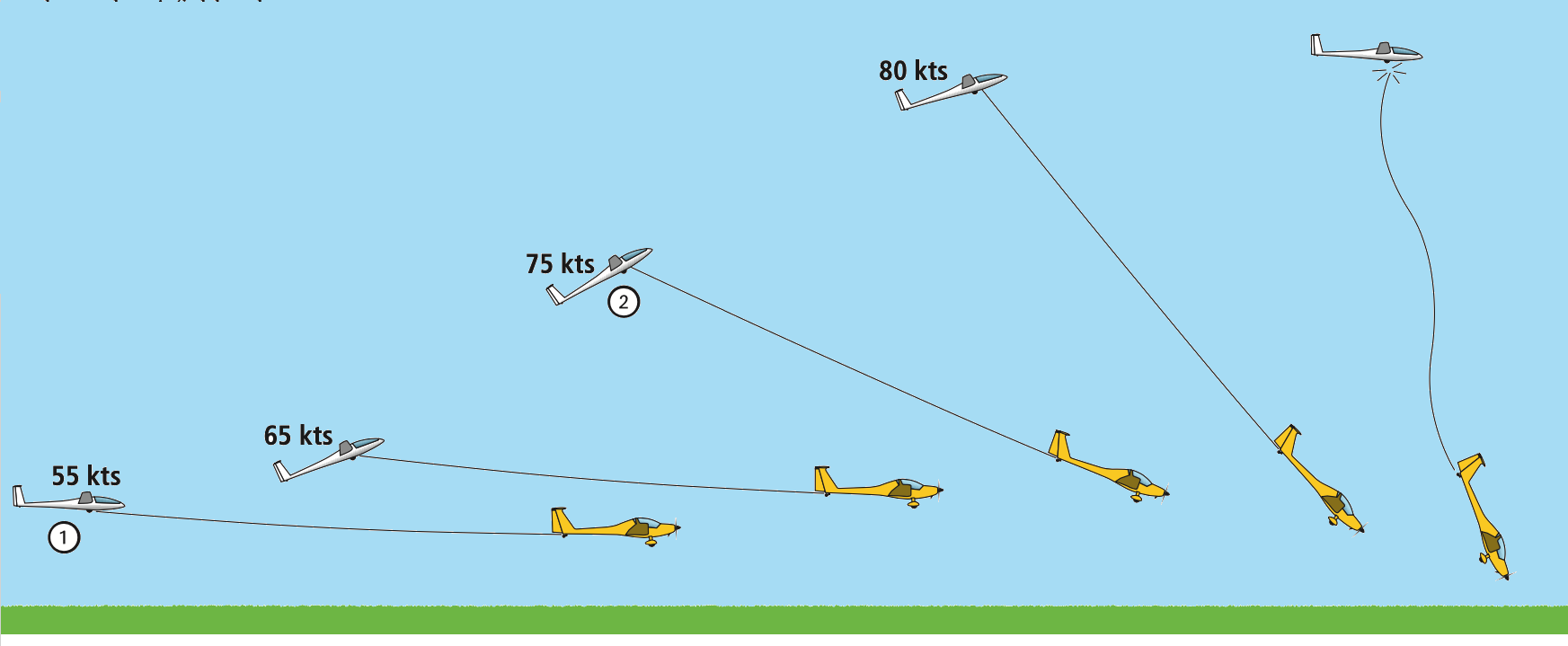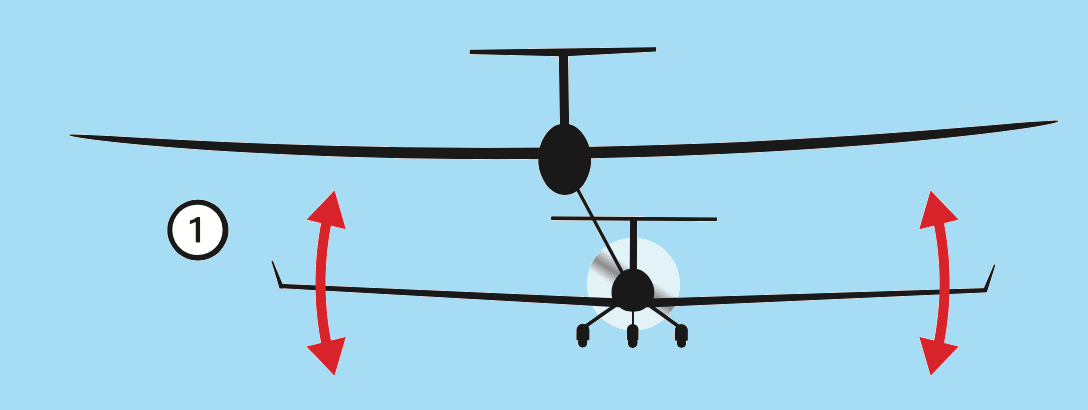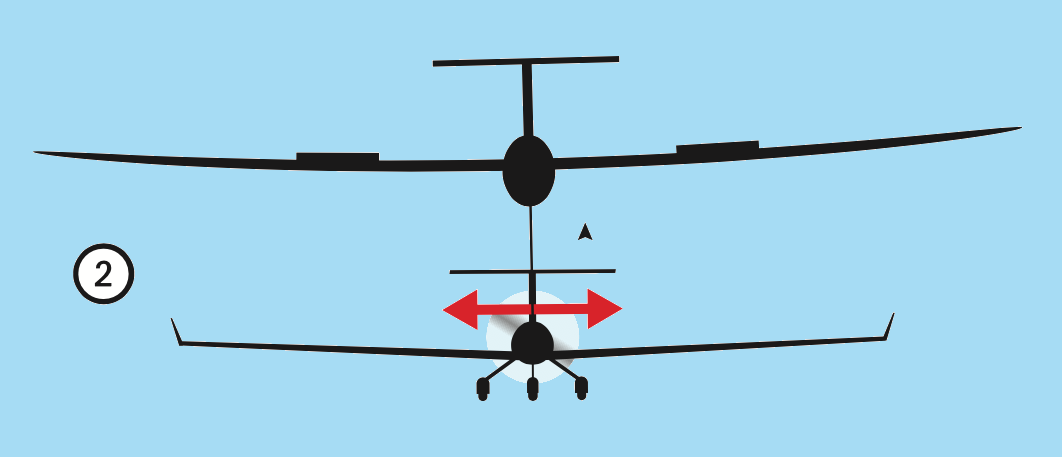4. LESSON 29 - AEROTOW - EMERGENCY PROCEDURES
Key points:
- Plan and discuss the eventualities before every launch
- Know the suitable field landing spots in the direct vicinity of the airfield
An aerotow launch very rarely gets interrupted, and rope break during the climb almost never occurs. But we must prepare for everything. The procedures for an aerotow launch failure are different from a winch cable break. The rate of climb during an aerotow is much lower than it is during a winch launch. The most critical point for an aerotow launch failure lies further down the airfield or beyond, at a much lower height above the ground.
Possible errors on the ground:
- The glider pilot is unable to keep the wings level
- The glider veers off to one side due to the weathervane effect
- The glider rolls over the tow rope with its main wheel
- The tug accelerates before the rope is tight
Possible errors during the climb:
- A tug upset (aka ‘Slingshot’), see below
- The glider pilot is unable to maintain position behind the tug
- A power loss or engine failure of the tug
- A rope break
In all these cases you must release immediately!
TUG UPSET (aka ‘Slingshot’)
Compared to other launch methods aerotow launching is even safer. One of the biggest risks is that the glider can climb too high above the tug. In Lesson 4.16 we already stressed how you should make sure you only adopt a slightly higher position to stay above the slipstream. This position is called the normal tow position (1). When a glider rises too high above the tug (a tug upset), the glider can swing up, slowing the tug down and forcing it into a steep dive (2). Consideration of tug upsets is important for both glider and towing pilots. While it is the tug pilot who will suffer the consequences – sometimes fatal – it is the glider pilot who can prevent them. Don’t underestimate the risk; just two to three seconds of distraction can result in a slingshot. In other words: keep a constant eye on the tug and if you suddenly can’t see it anymore (because you’ve climbed too high): release immediately!
DISTRACTIONS
Example: You only notice the racket from an open DV panel (the sliding window) when close to lift off, perhaps the trickiest part of the tow. Do not let yourself get distracted at this point! Stay focussed on position keeping and simply live with the noise until much higher.
LAUNCH FAILURES
Aerotowing shares the same fundamental principles with other methods such as winch, autotow, self-launch or TMG (Touring Motor Glider). In the event of a launch failure, the decision-making chain (see Lesson 4.33) is:
- First fly the aircraft, then
- Decide a plan
- Fly the plan accurately
All this has to be done by a pilot who may well be surprised and thus performing at less than his/her best.
Aerotows have some advantages. While failures are not unknown, they are very rare. Towing speeds are generally close to approach speed and a towing attitude is flat. For that reason, the abrupt nose down pitch needed after a winch failure is not required. Flying the glider is rarely too much of a challenge, although the vital importance of maintaining speed remains. However, if an aerotow launch failure should occur below a height where it is safe to turn back, the only option will be to land more-or-less straight ahead, and off-airfield if necessary. There’s only a very small chance of a low-height launch failure on any particular aerotow, but you must nevertheless use the E-Eventualities item in your pre-flight checklist to mentally prepare for it before every aerotow. Your instructor will brief you on which fields or other off-airfield landing areas you could use if it happens, and the minimum height below which you must not attempt to turn back at your particular site. Only once above this height should you consider turning back to the airfield, and landing down-wind if appropriate.
AEROTOW SIGNALS
Usually you will be able to communicate with the tug pilot by radio. If this is for some reason impossible you can still communicate via flight control inputs.
1 Wing rock by the tug is a mandatory instruction that the glider must release immediately!
In Lesson 4.16 you have already become acquainted with the signal to release. Even if this signal comes at a time when you don’t expect it you should release immediately. For example, the tug may have engine problems and the tug pilot has to interrupt the launch.
2 Waggling tug rudder means the glider pilot should check the airbrakes
Sadly, from time to time, aerotows are attempted with the airbrakes open. It doesn’t matter whether they were missed in the pre-flight checks or the lock, for some reason, didn’t keep them in, the result is the same: a dangerous increase in drag and a decrease of performance or the glider/ tug combination. If the tug waggles its rudder, check the airbrakes without losing sight of the tug. A quick radio call, of course, should sort things out without delay but if that doesn’t work, or isn’t possible, there is this pre-planned signal.
Canopy opening
As with open airbrakes, prevention, i.e. proper pre-flight preparation, is far better than cure. Unlike airbrakes, an open or opening canopy is immediately apparent to the glider pilot, alarming even.
If an alarmed glider pilot is distracted from their first priority to fly the aircraft, then a tug upset can rapidly result.
So you must:
- Continue to maintain position behind the tug, even with the canopy open
- Only when height and spare capacity permits, sort out the canopy
GLIDER PILOT IS UNABLE TO RELEASE
In the very unlikely event that the glider is unable to release the rope and communication by radio is also not possible:
- First try another pull; in a two-seater try the other release knob
- If still attached, and a radio call has not alerted the tug pilot, fly well to the left, positively rocking your wings. Rock away from the tug first to save charging back towards the middle (3)
- Anticipate being brought back to the site before the tug end of the rope is released (this is called descending on tow)
DESCENDING ON TOW
When descending on tow, you should apply normal position keeping techniques, with sensible use of airbrakes to manage any slack in the rope (nose down is appropriate only for the most gentle of descents). With the glider holding position this way landings on tow are possible.






